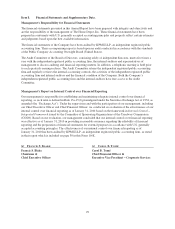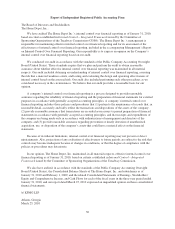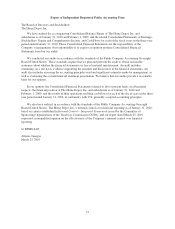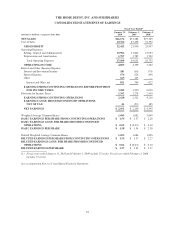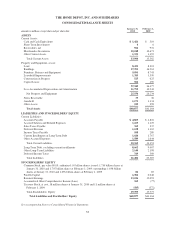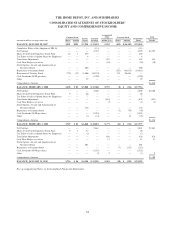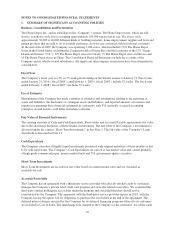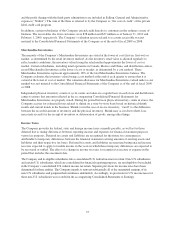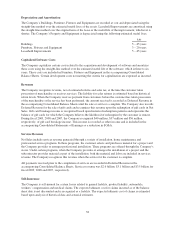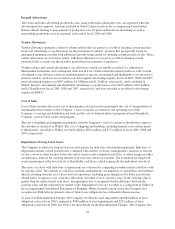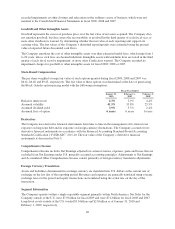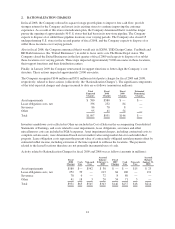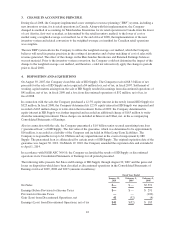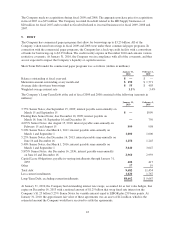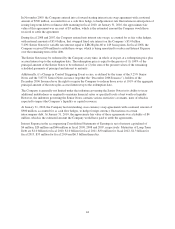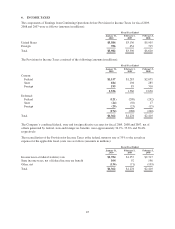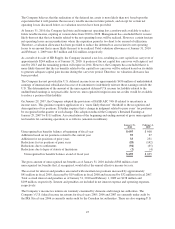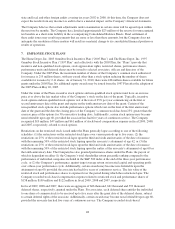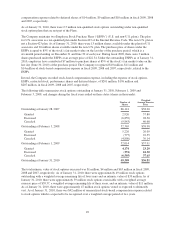Home Depot 2009 Annual Report Download - page 45
Download and view the complete annual report
Please find page 45 of the 2009 Home Depot annual report below. You can navigate through the pages in the report by either clicking on the pages listed below, or by using the keyword search tool below to find specific information within the annual report.Prepaid Advertising
Television and radio advertising production costs, along with media placement costs, are expensed when the
advertisement first appears. Amounts included in Other Current Assets in the accompanying Consolidated
Balance Sheets relating to prepayments of production costs for print and broadcast advertising as well as
sponsorship promotions were not material at the end of fiscal 2009 and 2008.
Vendor Allowances
Vendor allowances primarily consist of volume rebates that are earned as a result of attaining certain purchase
levels and advertising co-op allowances for the promotion of vendors’ products that are typically based on
guaranteed minimum amounts with additional amounts being earned for attaining certain purchase levels. These
vendor allowances are accrued as earned, with those allowances received as a result of attaining certain
purchase levels accrued over the incentive period based on estimates of purchases.
Volume rebates and certain advertising co-op allowances earned are initially recorded as a reduction in
Merchandise Inventories and a subsequent reduction in Cost of Sales when the related product is sold. Certain
advertising co-op allowances that are reimbursements of specific, incremental and identifiable costs incurred to
promote vendors’ products are recorded as an offset against advertising expense. In fiscal 2009, 2008 and 2007,
gross advertising expense was $897 million, $1.0 billion and $1.2 billion, respectively, and is included in
SG&A. Specific, incremental and identifiable advertising co-op allowances were $105 million, $107 million
and $120 million for fiscal 2009, 2008 and 2007, respectively, and were recorded as an offset to advertising
expense in SG&A.
Cost of Sales
Cost of Sales includes the actual cost of merchandise sold and services performed, the cost of transportation of
merchandise from vendors to the Company’s stores, locations or customers, the operating cost of the
Company’s sourcing and distribution network and the cost of deferred interest programs offered through the
Company’s private label credit card program.
The cost of handling and shipping merchandise from the Company’s stores, locations or distribution centers to
the customer is classified as SG&A. The cost of shipping and handling, including internal costs and payments
to third parties, classified as SG&A was $426 million, $501 million and $571 million in fiscal 2009, 2008 and
2007, respectively.
Impairment of Long-Lived Assets
The Company evaluates its long-lived assets each quarter for indicators of potential impairment. Indicators of
impairment include current period losses combined with a history of losses, management’s decision to relocate
or close a store or other location before the end of its previously estimated useful life, or when changes in other
circumstances indicate the carrying amount of an asset may not be recoverable. The evaluation for long-lived
assets is performed at the lowest level of identifiable cash flows, which is generally the individual store level.
The assets of a store with indicators of impairment are evaluated by comparing its undiscounted cash flows with
its carrying value. The estimate of cash flows includes management’s assumptions of cash inflows and outflows
directly resulting from the use of those assets in operations, including gross margin on Net Sales, payroll and
related items, occupancy costs, insurance allocations and other costs to operate a store. If the carrying value is
greater than the undiscounted cash flows, an impairment loss is recognized for the difference between the
carrying value and the estimated fair market value. Impairment losses are recorded as a component of SG&A in
the accompanying Consolidated Statements of Earnings. When a leased location closes, the Company also
recognizes in SG&A the net present value of future lease obligations less estimated sublease income.
As part of its Rationalization Charges, the Company recorded no asset impairment and $84 million of lease
obligation costs in fiscal 2009 compared to $580 million of asset impairments and $252 million of lease
obligation costs in fiscal 2008. See Note 2 for more details on the Rationalization Charges. The Company also
39


